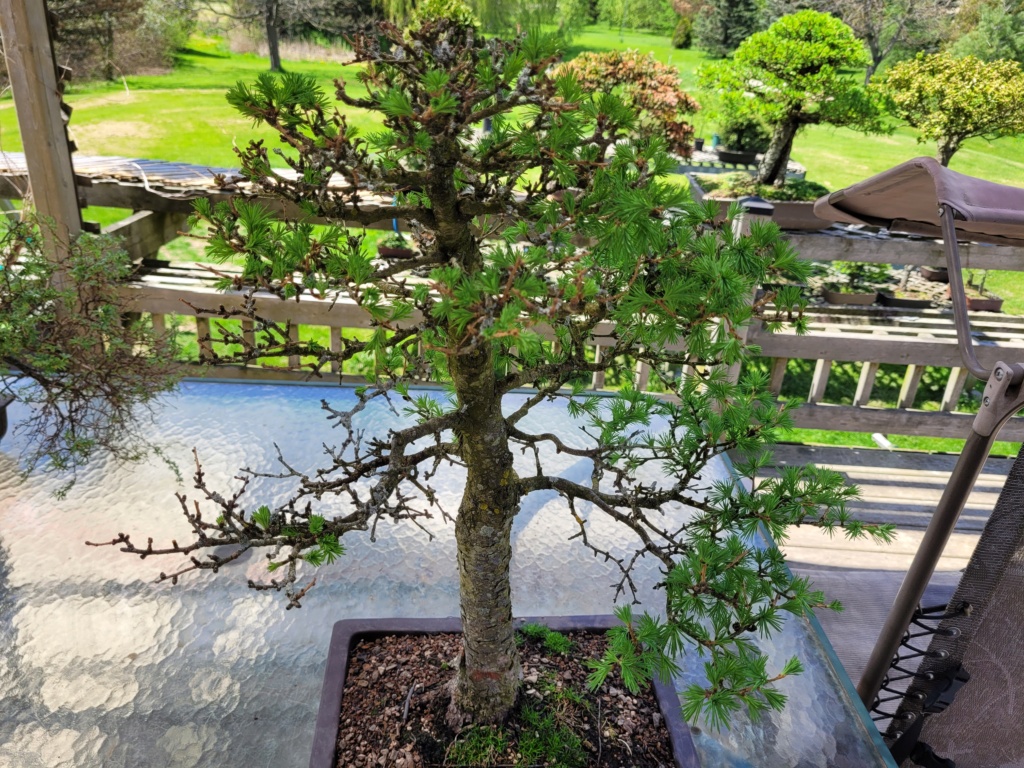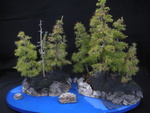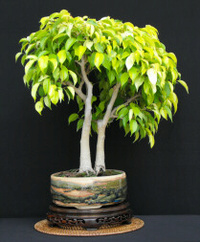Weakened larches
3 posters
Page 1 of 1
 Weakened larches
Weakened larches
Hi:
I have cultivating bonsai for over 15 years, but in the last two years I noticed that several of my old larches have been getting weak, specially the lower branches. Last year I tried to prune the top to promote growth in the bottom branches, but it is not working and the trees are getting weaker. Here are pictures of two of the weakened larches. Any ideas of what I am doing wrong and how to correct the situation are very welcome. Thanks.

I have cultivating bonsai for over 15 years, but in the last two years I noticed that several of my old larches have been getting weak, specially the lower branches. Last year I tried to prune the top to promote growth in the bottom branches, but it is not working and the trees are getting weaker. Here are pictures of two of the weakened larches. Any ideas of what I am doing wrong and how to correct the situation are very welcome. Thanks.



ivillaCanada- Member
 Re: Weakened larches
Re: Weakened larches
What is the soil condition and when did you last repot them? What are you using for soil?
I grow mine in akadama-lava-pumice typically about 2-1-1 since larch use lots of water. I repot about every 3 years. I lost a back branch on one about the same age as yours last year, but I think it may have been our abnormally hot summer and that side of the pot seeing too much sun.
Marty
I grow mine in akadama-lava-pumice typically about 2-1-1 since larch use lots of water. I repot about every 3 years. I lost a back branch on one about the same age as yours last year, but I think it may have been our abnormally hot summer and that side of the pot seeing too much sun.
Marty
Marty Weiser- Member
 Weakened larches
Weakened larches
Hi Marty:
Thanks for your reply. My bonsai soil is granite, turface & bark 2:1:1. When I started to cultivate bonsai I was using granite, turface, bark and clay soil, about 1/4 each, but several people told me not to use the clay soil so I eliminated it from my bonsai soil several years ago. Now that I have used both, I believe that the trees were healthier when I was using some clay in the soil, so I am thinking in going back to using some.
I have most of my trees in full sun, but I was thinking in installing some shade to protect them from the hottest part of the day.
With regard to the repotting time, depending on the tree, some I repot every year if there are very active and growing and some I wait 5 years, but most about every 3 years.
I also noticed that the ones that are now in the "right" bonsai pot size seem to be getting weak compared to the ones that are a little over-potted. Do you use bigger pot size even in your refined bonsai trees?
Where do you keep your hardy bonsai trees during winter? I use a plastic greenhouse with all the windows completely open, so it does not get hot during sunny days, but it protect them from wind and rodents. The problem is that, since they do not get any snow or rain I have to keep watering them. I have been thinking about leaving them on the ground and surrounded by burlap to protect them from the wind.
Thanks for your reply. My bonsai soil is granite, turface & bark 2:1:1. When I started to cultivate bonsai I was using granite, turface, bark and clay soil, about 1/4 each, but several people told me not to use the clay soil so I eliminated it from my bonsai soil several years ago. Now that I have used both, I believe that the trees were healthier when I was using some clay in the soil, so I am thinking in going back to using some.
I have most of my trees in full sun, but I was thinking in installing some shade to protect them from the hottest part of the day.
With regard to the repotting time, depending on the tree, some I repot every year if there are very active and growing and some I wait 5 years, but most about every 3 years.
I also noticed that the ones that are now in the "right" bonsai pot size seem to be getting weak compared to the ones that are a little over-potted. Do you use bigger pot size even in your refined bonsai trees?
Where do you keep your hardy bonsai trees during winter? I use a plastic greenhouse with all the windows completely open, so it does not get hot during sunny days, but it protect them from wind and rodents. The problem is that, since they do not get any snow or rain I have to keep watering them. I have been thinking about leaving them on the ground and surrounded by burlap to protect them from the wind.

ivillaCanada- Member
 Re: Weakened larches
Re: Weakened larches
Compared to yours mine are in somewhat oversized bonsai pots. I wonder if your soil mix might be a bit dry for larch. Pumice would be the low cost way to increase the moisture level (and it would also make the pots lighter). I went away from bark in my bonsai pots (I use it for growing developmental stuff) since I had what I felt were root rot issues. if by clay you mean akadama, I have found that high quality akadama is a very good soil component. However, I have not got to 100% akadama for deciduous trees as some advocate - I use 2/3 at the max and 50% for larch.
I have over winter my larch in refinement in my greenhouse where my target temperature is 34F (1C). It will get a bit warmer on warm sunny days, but not much above the ambient temperatures which rarely exceed 45F (7C) in the midst of winter. I have kept them on the ground with protection, but now use the greenhouse since I have it dialed in. However, it seems to be getting fuller of things that need the protection so they may go back out on the ground with good protection. I have seen -10F (-23C) here, but not for many years. 0 to 5F (-18 to -15C) or a bit warmer has been more common recently.
I think that protecting the pot from overheating in the midst of summer is more important than protecting the foliage. I grow Japanese larch (L. kaempferi). I worked with Western larch (L. occidentalis) and found that it was very susceptible to the roots overheating - the side of the box with a forest that faced the sun would die off year after year.
I have over winter my larch in refinement in my greenhouse where my target temperature is 34F (1C). It will get a bit warmer on warm sunny days, but not much above the ambient temperatures which rarely exceed 45F (7C) in the midst of winter. I have kept them on the ground with protection, but now use the greenhouse since I have it dialed in. However, it seems to be getting fuller of things that need the protection so they may go back out on the ground with good protection. I have seen -10F (-23C) here, but not for many years. 0 to 5F (-18 to -15C) or a bit warmer has been more common recently.
I think that protecting the pot from overheating in the midst of summer is more important than protecting the foliage. I grow Japanese larch (L. kaempferi). I worked with Western larch (L. occidentalis) and found that it was very susceptible to the roots overheating - the side of the box with a forest that faced the sun would die off year after year.
Marty Weiser- Member
 Weakened larches
Weakened larches
Hi Marty:
Thanks very much for your reply and recommendations. I believe that they are very valid. I have not seen the same kind of problems that I have with my larches, with other trees like junipers and cedars, so I believe that you are right. I will add some pumice to increase the water retention and may add some share to reduce the possibility of pot overheating.
When you leave your trees in the greenhouse during the winter, how often do you water them?
Thanks very much for your reply and recommendations. I believe that they are very valid. I have not seen the same kind of problems that I have with my larches, with other trees like junipers and cedars, so I believe that you are right. I will add some pumice to increase the water retention and may add some share to reduce the possibility of pot overheating.
When you leave your trees in the greenhouse during the winter, how often do you water them?

ivillaCanada- Member
 Re: Weakened larches
Re: Weakened larches
I water the trees in the greenhouse about once a month, more often as the temperature is higher and there is more sun and perhaps a bit less frequently if it has been cold and dark so they use less water even though they are above freezing. I have shade cloth over the greenhouse and it has multiple layers of plastic so even direct sun is diffuse.
Marty Weiser- Member
 Re: Weakened larches
Re: Weakened larches
Wood, -branches are not forever. That fact doesn't matter in nature because growth occurs where the conditions are best on the tree and life goes on. Bonsai are the antithesis of good natural processes. We clip off new in favor of keeping old. It gets worse, the closer we get to our idealized form, the closer a given branch is to "too old". There are conflicting mandates in the creation and the maintenance of good bonsai: It takes some time, tweaking over some years, getting closer and closer to a finished form. When we finally arrive at the perfect design, we try to maintain it just as it is. If we do that long enough the branch gets beyond a lifespan and often dies over winter or the non-growing season. There are only just so many dormant buds within a given stretch older bark, the older, the fewer. Lots of older wood won't bud back at all, species dependent of course, but on a branch that that's 20 feet long, who cares? Those branch ends are growing new tips year after year and life goes on.
To keep a bonsai looking perfect forever doesn't work. We need a strategy of renewal every few years, cutting back hard all over to force new growth on older, but not too old, wood. Of course this means a couple years of re-tweaking it back into finished form so you can't keep a tree in top display form for more than a few years at a time, again species dependent and of course design dependent. Some designs on some species are closer to the edge. Doing this major work to a perfectly good perfect tree is a tough pill to swallow. Tough Love is what it is, -wait too long and pay the piper. We do year-to-year a higher amount of apical trimming to favor lower parts' growing conditions and that helps, but the lower branches being older and less favored by nature because it would normally be expendable anyway are still always going to be of higher risk. No matter where a tree grows in nature there is a sunny side and a less favorable condition somewhere on the 360° perimeter. The tree survives because it doesn't matter to Mother Nature. Bonsai uses that side as the rear and that works until those branches get to some critical age. Reversing the front and rear is one way of extending the life of the tree, but that takes some doing and many people would be intellectually offended by the idea. Planning for that is difficult for the artistically challenged.
If we keep all this in mind and plan ahead for heavy re-styling every 3 or 5 or 10 or whatever species dependent years parameter is necessary, the pain involved can be mitigated, or at least anticipated and tolerated. Naturally, observing the standard rules of bonsai design incorporated in the more pointy pyramidal, wide bottom form helps from the beginning. The tree foliage/design at the beginning of this post is too thick on top by that standard and shades the lower sections. Larch are full sun all the time trees, no exceptions. They are native to cool-root zones, so pots that do not stay cool in the sun (by staying moist all day in a pot) are going to suffer. Western (American) Larch are trees of cooler elevations, and Eastern American Larch are bog dwellers, both are from higher latitudes and each cooling roots by different methods. Any bonsai condition that is less than perfect on any tree that is in a pot lessens the lifespan of all, but especially older parts, again species dependent.
To keep a bonsai looking perfect forever doesn't work. We need a strategy of renewal every few years, cutting back hard all over to force new growth on older, but not too old, wood. Of course this means a couple years of re-tweaking it back into finished form so you can't keep a tree in top display form for more than a few years at a time, again species dependent and of course design dependent. Some designs on some species are closer to the edge. Doing this major work to a perfectly good perfect tree is a tough pill to swallow. Tough Love is what it is, -wait too long and pay the piper. We do year-to-year a higher amount of apical trimming to favor lower parts' growing conditions and that helps, but the lower branches being older and less favored by nature because it would normally be expendable anyway are still always going to be of higher risk. No matter where a tree grows in nature there is a sunny side and a less favorable condition somewhere on the 360° perimeter. The tree survives because it doesn't matter to Mother Nature. Bonsai uses that side as the rear and that works until those branches get to some critical age. Reversing the front and rear is one way of extending the life of the tree, but that takes some doing and many people would be intellectually offended by the idea. Planning for that is difficult for the artistically challenged.
If we keep all this in mind and plan ahead for heavy re-styling every 3 or 5 or 10 or whatever species dependent years parameter is necessary, the pain involved can be mitigated, or at least anticipated and tolerated. Naturally, observing the standard rules of bonsai design incorporated in the more pointy pyramidal, wide bottom form helps from the beginning. The tree foliage/design at the beginning of this post is too thick on top by that standard and shades the lower sections. Larch are full sun all the time trees, no exceptions. They are native to cool-root zones, so pots that do not stay cool in the sun (by staying moist all day in a pot) are going to suffer. Western (American) Larch are trees of cooler elevations, and Eastern American Larch are bog dwellers, both are from higher latitudes and each cooling roots by different methods. Any bonsai condition that is less than perfect on any tree that is in a pot lessens the lifespan of all, but especially older parts, again species dependent.

Michigander- Member
 Similar topics
Similar topics» Workshop Larches in Norfolk.
» Some Larches
» Differences between Larches
» new collected larches
» tamaracks, larches
» Some Larches
» Differences between Larches
» new collected larches
» tamaracks, larches
Page 1 of 1
Permissions in this forum:
You cannot reply to topics in this forum






